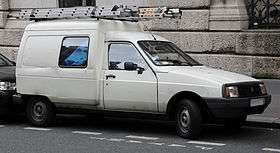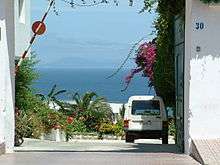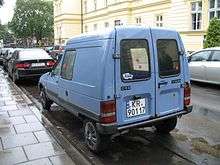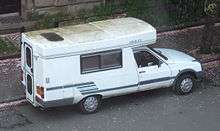Citroën C15
| Citroën C15 | |
|---|---|
 Early (1984-1989) version | |
| Overview | |
| Manufacturer | Citroën |
| Production | 1984—2005 |
| Assembly |
Spain: Vigo (Centro de Vigo) Portugal: Mangualde (PSA Mangualde) |
| Body and chassis | |
| Class | Leisure activity vehicle (M) |
| Body style | Panel van |
| Layout | FF layout |
| Related | Citroën Visa |
| Chronology | |
| Predecessor | Citroën Acadiane |
| Successor | Citroën Berlingo |



The Citroën C15 was a panel van produced by the French manufacturer Citroën from 1984 until 2005. It was the successor to the Citroën Acadiane which had replaced the Citroën 2CV vans that pioneered the box van format in the 1950s - 1970s. The name refers to the car's 1,500 kg (3,310 lb) French gross vehicle weight rating.
Design
The C15 was based on the Citroën Visa (discontinued 1988), and mainly used a 1769 cc XUD or 1868 cc (DW8 on late models), naturally aspirated (non-turbo) diesel engine. Until the early 1990s it was also available with a petrol PSA TU engine. While the car ahead of the B-pillar was mostly the same as a regular Citroën Visa, the cargo area was unique. The rear axle had to carry heavy loads and so a sturdier Citroën BX unit was installed rather than the Visa one.
As well as standard van configuration, the vehicle was available with rear side-windows and a rear seat, (which had been pioneered in the 2CV), which can be seen as a forerunner to today's utility vehicles such as the Ford Transit Connect, Opel/Vauxhall Combo, Citroën Berlingo and Peugeot Partner. The C15 was available without the rear box section, as a 'chassis only' model. Rare pickup truck versions were also made.
By 2005, when it was discontinued, production had reached 1,181,471. The last three built were given to:
- The government of Vigo city in Spain, where the production of this car was held for last few years
- Museum of Citroën cars in Aulnay
- One for the Vigo car factory, where it was built
Over its 21-year production run, there were various minor changes and upgrades made. Models with 600 kg and 800 kg load capacities were introduced (the original was 500 kg). Trim details were changed to give it a facelift in September 1989, when a lower grille with three cross bars was introduced, with the turn signals now mounted in the bumper and with an off-set Citroën logo. In 1992, side plastic trims were added, and the bonnet trim again changed somewhat.
The design was simple, but very reliable and effective, resulting in a remarkably successful 21-year production run, in comparison to the Visa hatchback from which it was derived, which was produced for only ten years. The C15 had a lengthened wheelbase, and a rear axle taken from the Peugeot 305 break. The vehicle is very basic by modern standards, but this made it cheap to build, cheap to run and hard to break.
The availability of the vehicle with a 'chassis only' rear portion encouraged various conversions. The C15 was used as a camper-van base by Island Plastics, branding the resulting vehicle the RomaHome. It was a surprisingly practical small camper for two people.
Variants and history
The C15 was introduced in the UK in 1985, initially badged with the pun 'van blanc' or 'van rouge' according to body colour. UK models were always shipped without rear side windows, as is usual for UK vans, due to tax regulations. European models had side windows, and a 'combi' version called 'Weekend', with an easily removed rear bench seat. There was also, in France at least, a rather rare 'stretched' version, which was about 0.5m longer than a normal C15. The very curved sides of the windscreen, enabled the use of a very large single wiper on the long narrow windscreen, without it catching the windscreen seal. The shape of the bumper and plastic trim on the front of the van, like the Visa car, was designed to aerodynamically reduce the deposition of dirt on the headlights, and to reduce the risk of stone chips to the headlights, bonnet and windscreen. The heating and ventilation system, (even though it used only a water control valve for temperature control and not air mixing), could provide cold air from fascia side vents, to the face while warming the car. The central directable fascia vents could be heated and angled, so that they could be pointed directly at the windscreen in front of the driver, to keep it clear in extreme misting conditions. There was also an additional mid level vent. The C15 also had height adjustable halogen headlights, and multi-speed / intermittent front wipers, which was better than most commercial vehicles of the time. Early models had a single wide rear door, but this was awkward for loading in a tight space and prone to sagging or to snapping off in a high wind, so, after a year or two, only conventional 2-door versions were sold with fold back hinges.
The engine used was the extremely rugged and reliable PSA XUD series: XUD7 (1.7l) and (DW8 1.9l on later models). It also powered vehicles several classes larger, and made light work of powering the lightweight C15. Both Bosch and Lucas/CAV/Roto-diesel injection systems were used. A small number of TU petrol engined versions were also sold until the early 1990s. The engines and drivetrains were originally taken from the Peugeot 205 and were the same as fitted to the diesel Citroën Visa.
Numerous changes were made to the engine ancillaries over the years. Early models had an in-line electrical diesel heater, which invariably stopped working after a couple of years, but made no difference, unless used in very cold conditions, so it wasn't fitted on later UK models, the fuel passing over the thermostat housing to warm it up instead. The fuel filter moved from the wing to the top of the thermostat housing. The oil filler moved from the crankcase cover to the dipstick housing.
The front indicators were originally combined with the headlights, but later replaced by side lights (moved from the headlight reflector) and separate indicators were fitted in the bumper.
See also
External links
| Wikimedia Commons has media related to Citroën C15. |
| « previous — Citroën car timeline, 1980s–present | |||||||||||||||||||||||||||||||||||||
|---|---|---|---|---|---|---|---|---|---|---|---|---|---|---|---|---|---|---|---|---|---|---|---|---|---|---|---|---|---|---|---|---|---|---|---|---|---|
| Type | 1980s | 1990s | 2000s | 2010s | |||||||||||||||||||||||||||||||||
| 0 | 1 | 2 | 3 | 4 | 5 | 6 | 7 | 8 | 9 | 0 | 1 | 2 | 3 | 4 | 5 | 6 | 7 | 8 | 9 | 0 | 1 | 2 | 3 | 4 | 5 | 6 | 7 | 8 | 9 | 0 | 1 | 2 | 3 | 4 | 5 | 6 | |
| Economy car | 2CV | ||||||||||||||||||||||||||||||||||||
| Off-roader | Méhari | ||||||||||||||||||||||||||||||||||||
| City car | C1 I | C1 II | |||||||||||||||||||||||||||||||||||
| Supermini | LN / LNA | AX | |||||||||||||||||||||||||||||||||||
| Dyane | Axel | Saxo | C2 | DS3 | |||||||||||||||||||||||||||||||||
| Visa | C3 I | C3 II | |||||||||||||||||||||||||||||||||||
| Small family car | C4 Cactus | ||||||||||||||||||||||||||||||||||||
| GSA | ZX | Xsara | C4 I | C4 II | |||||||||||||||||||||||||||||||||
| DS4 | |||||||||||||||||||||||||||||||||||||
| Large family car | BX | Xantia | C5 I | C5 II | |||||||||||||||||||||||||||||||||
| DS5 | |||||||||||||||||||||||||||||||||||||
| Executive car | CX | XM | C6 | ||||||||||||||||||||||||||||||||||
| Convertible | Visa cabriolet | C3 Pluriel | |||||||||||||||||||||||||||||||||||
| Mini MPV | Nemo Multispace | ||||||||||||||||||||||||||||||||||||
| Compact MPV | Xsara Picasso | C3 Picasso | |||||||||||||||||||||||||||||||||||
| C4 Picasso I | C4 Picasso II | ||||||||||||||||||||||||||||||||||||
| Large MPV | Evasion | C8 | |||||||||||||||||||||||||||||||||||
| Crossover SUV | C-Crosser | C4 Aircross | |||||||||||||||||||||||||||||||||||
| LAV | Acadiane | C15 | Nemo | ||||||||||||||||||||||||||||||||||
| Berlingo | Berlingo II | ||||||||||||||||||||||||||||||||||||
| Van | H Van | C25 | Jumpy I | Jumpy II | Space Tourer | ||||||||||||||||||||||||||||||||
| C35 | Jumper I | Jumper II | |||||||||||||||||||||||||||||||||||